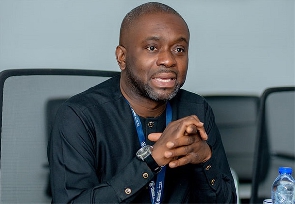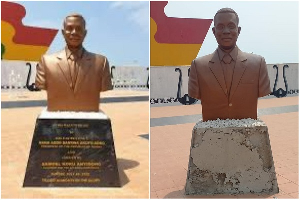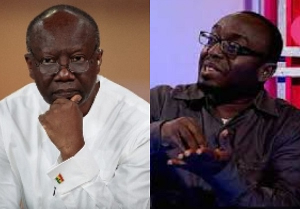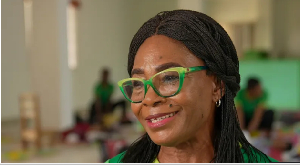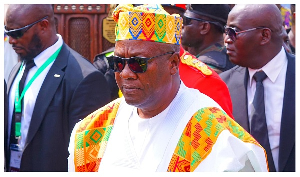The Ghana Minerals Income Investment Fund is defying the odds and the general economic downturn plaguing the world with its meteoric rise in just 18 months.
From circa US$125 million dollars in October 2021, the Assets Under Management (AUM) for the Fund are set to reach the One-billion-dollar mark by January 2024 making it one of the fastest-growing specialised funds in the world over the same period.
“The growth trajectory of the Fund is attributed to the hard work of the entire team at MIIF. They have powered this incredible rise in the last 18- months. The key issues for us, as a Fund is keeping fidelity to the founding law and the President’s vision to create long term sustainable value for Ghanaians.
"We have been able to build the AUM by innovatively expanding our royalties base, the performance of the gold sector, strategic investments, good asset allocation and our treasury management” says Edward Nana Yaw Koranteng, the Chief Executive Officer.
According to Mr. Koranteng, Ghana has been the heartbeat of West African mining for centuries and currently the number one gold producer on the continent. The industry is however seen as not having met its promise of bringing long term prosperity and opportunity to Ghana.
It is on this premise that the President of Ghana, Nana Addo Dankwa Akufo-Addo, envisioned the setup of the Minerals Income Investment Fund through an Act of Parliament (Act 978) in 2018 to manage all of Government of Ghana’s equity interests in mining companies, manage and invest royalties and dividends received from all minerals into selective investments across the entire mining value chain and to develop and implement measures to reduce the budgetary exposure of the Republic to minerals income fluctuations.
The President’s Charge
“Hopeful this Fund, when properly managed and selectively invested, will over the period of time erase that image and give us a new architecture in the mining industry which includes significant Ghanaian players,” President Nana Addo Dankwa Akufo-Addo.
In October 2021, President Akufo-Addo appointed a new Board of Directors for MIIF chaired by Professor Douglas Boateng, a Professor Extraordinaire in Supply Chain Management and Edward Nana Yaw Koranteng, a lawyer and an investment banker with experience covering Ghana, United Kingdom and sub-Saharan Africa as Chief Executive Officer of the Fund.
“The President charged us to create long term value for Ghanaians. Create a conducive investment environment around the participation of Ghanaians in the mining sector and to make Ghanaians the primary beneficiaries of the natural resources God has bestowed on our motherland. These words underpin the objectives of the Fund and are fundamental in the way we approach business ” says Edward Koranteng.
Getting the Fundamentals Right
Expanding the Royalties Base
The main sources of income for the Fund are royalties and dividend payments. Royalties from the minerals are however more constant with gold attributing for about 93% of all royalties. Ghana has about 15 royalties paying minerals including gold. The initial challenge for the Fund was on how to expand the royalties net which apart from large-scale gold was unimpressive. The Fund in this vein developed two main initiatives.
InterAgency Framework and Committee
The Fund in expanding the royalties base from non-gold minerals such as manganese, salt, sand winning, limestone and quarrying activities established an inter-agency framework and task force. This task force is made up of GRA, MDF, Ghana Standards Authority, Minerals Commission, and EOCO.
The framework is part of the strategic thrust of MIIF to enhance the collection of royalties, expand the royalties net and streamline communication on royalty payments from non-gold mining companies. Since the initiative started in December 2021, MIIF, for the first time in its history, receives royalties from sand winners, salt and silver. Royalties from quarries and limestone activities have surged over 105% and 125% respectively”.
Royalty Tracking System
The Fund has also developed an in-house geo-mapping and monitoring system that allows a real-time view of mining activities from selected mines in Ghana. This allows tracking of mining companies and payment of royalties on time with the support of the Inter-Agency.
Developing a Sector Beyond Gold
“Gold is very important because it represents about 93% of our royalties” admits Edward Nana Yaw Koranteng. The Fund has invested US$ 40 Million in Asante Gold Corporation which is listed in Canada, Germany and now on the Ghana Stock Exchange. Asante owns the prolific Bibiani gold mine and the Chirano gold mine which used to be owned by Kinross of Canada. The investment in Asante has contributed to the highest Ghanaian stake in any international mine with over 40% Ghanaian ownership.
MIIF is however developing initiatives and investment programs to support the development of the other 16 mineral types in Ghana. To achieve the objective of developing a value-laden integrated mining sector that would bring long-term sustainable value to Ghanaians, it is important that MIIF directs/ investment in these mineral sectors and across their individual value chains.
“The core really, is for us to diversify the mineral base where we get our royalties. We are not just looking at the mineral space, we are looking at the entire value chain.” As such, MIIF has developed a strategy for every mineral type in a bid to extensively develop and invest in that mineral’s value delivery system. Ghana can only transform if we hold significant equity positions across the entire value chain for every single mineral” -Edward Nana Yaw Koranteng.
The Salt Opportunity
“Industrial salt is one such mineral if well-developed across its value chain could generate at least US$1 billion in direct revenue every year. At Ada, which is a coastal town in Ghana, the Songhor Salt Pans sits on 41,000 acres and can become the biggest producing facility in Africa. The Walvis Bay in Namibia which is the largest in sub-Saharan Africa at 16,700 acres produces circa 950,000 tons per annum”. Mr. Koranteng stated that the value of salt is in value addition with over 14,000 uses covering oil and gas, mining, food processing, pharmaceuticals, caustic soda, preservatives, textiles, bicarbonate soda etc.
Industrial salt is projected to become a US$49 Billion market in 2030. Mr. Koranteng emphasised that salt is a priority mineral, and the development of the Ada enclave would be transformative for the Ada community and Ghana as a whole. He said, “the Nigerian demand is circa 800,000 tons per annum, but it imports mainly from Brazil because of the slow development of Ada Songhor in particular which is the only enclave in West Africa with potential purity of 99.9% industrial salt”.
A portion of the Ada Songhor salt pans is being developed by Electrochem Ghana with the company having invested over US$60 Million on its own and already constructed the largest salt loading bay in Africa with a long-term projected outlook of circa 2 Million tons of industrial salt per year. MIIF is investing up to GHS 300 Million in equity with a condition for the company to be listed on the Ghana Stock Exchange.
The Lithium Opportunity
According to Mr. Koranteng, the global lithium market size is currently valued at about US$38 billion and is projected to grow to US$ 90 Billion in 2030. The market value is estimated at US$ 8.2 Billion with an estimated growth at US$22.6 Billion by 2030. Lithium is a transformative mineral of high security and strategic importance for Ghana especially in the light of global decarbonization towards green energy.
Mr. Koranteng indicated that, MIIF is at an advanced stage in finalising a significant equity investment stake in the Australian and UK listed Atlantic Lithium which is developing the Ewoyaa lithium finds in Ghana. The Ewoyaa project which will be Ghana’s first lithium mine operation will produce 3.6 million tonnes of spodumene concentrate over a 12-year life with first production targeted for end 2024. The Ewoyaa project has a post-tax net present value (at 8% discount) of $1.5 billion, with free cash flow of $2.4 billion from life of mine revenues of $6.6 billion and an internal rate of return of 105%.
MIIF is investing circa $35 Million in the Ewoyaa lithium space with further plan to invest in value addition components such as chemical plants in line with Ghana’s proposed Critical Minerals Policy. The Fund will eventually invest in the development of the ceramic sector through the mineral feldspar (by-product of lithium) aimed at supporting strictly Ghanaian offtake and a Ghana ceramics development plan.
Formalising the Future of Ghana’s Gold and the Creation of a mining eco-system
The Small Scale Mining Incubation Program (SSMIP)
The Small-Scale Mining Incubation Program (SSMIP) is an investment package designed to help support the small-scale gold mining sector. The licensed small-scale sector contributes up to 40% of the total gold output of Ghana and employs more than 10% of the working population.
The MIIF Small-Scale Mining Incubation Program is an equity investment in the form of capital support, mining equipment, gold traceability mechanisms, imbuing beneficiary firms with proper corporate governance principles, exacting responsible mining methods to forestall environmental degradation as well as the provision of a ready offtake market through the MIIF Gold Trade Desk for the licensed miners.
According to the Chief Technical Officer and Head of Operations at MIIF, Mr. Kwabena Barning, “This initiative will be the most revolutionary in artisanal mining in Africa”. Mr. Koranteng emphasised the belief that the SSMIP has the potential to triple the small-scale output which is currently around US$ 2 Billion a year.
The objective of the SSMIP is to develop the creation of Ghanaian mid-tier gold mining companies, which would lead to the formalization of the sector with an attendant impact on eradicating illegal mining. In addition, this program plans to move beneficiary companies from their artisanal status to high performing junior mines which can be listed on the Ghana Stock Exchange. The pilot phase of this project has begun with an initial investment outlay of US$ 30 Million with a plan to cover over 100 companies in the next five years.
Developing the Capital Market
In March 2023, MIIF executed an MOU with the Ghana Stock Exchange (GSE). The MoU was signed with the view to establish a practical framework to set forth the procedures to create an alternative asset class and promote the trade in minerals securities on any of the GSE’s markets. In line with this MOU, MIIF shall endeavor to have all investments listed on the GSE. MIIF contributed immensely to having Asante Gold listed on the GSE and is currently working on investments in lithium, an advanced exploratory gold mine, salt and probably Kaolin with the intention to have these listed on the GSE.
MIIF Gold Backed ETF to be Listed on the GSE
The Fund is developing a gold backed ETF with the support of the GSE. This will be the second listed ETF after the ABSA South Africa New Gold ETF which has been trading on the GSE. The MIIF gold backed ETF would be a spin-off from the incubation program and backed by actual gold. The plan is to list the MIIF ETF in the first quarter of 2024.
Capacity Building and Human Resource Development
MIIF has developed a corporate social investment policy covering primarily education, health and resource capacity building. In this vein, MIIF is sponsoring the construction of the Technical Building of the University of Mines and Technology (UMaT) in Tarkwa. The Technical Building shall also include a jewelry making training center as part of the Fund’s objective of developing the gold value chain and get Ghana tapping into the US$650 Million global jewelry market.
In line with resource development, MIIF from 2024 January will be supporting a “Women in Mining” scholarship scheme for less privileged girls from the mining communities seeking to study at UMaT at both undergraduate or post graduate levels. The aim is to support up to 50 girls per cycle from the mining communities.
Investing in Local Content
The real value in mining according to Mr. Koranteng, through which Ghana could transform is for there to be significant Ghanaian equity positions in not only the mining companies but the entire supply chain or value chain. The recent local content directive under L.I. 2173, 2012 has virtually created a potential $5 Billion dollar economy under which 58 items for mining companies must be sourced locally.
These provisions provide opportunities for the manufacturing of mining components in Ghana, the creation of an expansive value chain, a complete Ghanaian indigenised mining contracting sector which hitherto was controlled by foreigners.
MIIF is developing investment product programs to inject equity in some of the major opportunities such as heavy mining. On the small scale and micro supplies level, however, MIIF has injected GHS25 Million into the Injaro Private Equity Fund which provides a conduit to providing debt to the mining SME and Micro level. This arrangement allows MIIF to cover the mining micro supply chain in line with the President’s vision.
MIIF as a Lever for Long-Term Development
The Chairman of MIIF, Prof. Douglas Boateng sums it up, “Our task is to be generational in our thinking. What we do is not for us. It is for the future of Ghana. In my view, MIIF is only beginning. With the opportunities in the mining sector, the ability of MIIF to continue to invest will create a difference in the future for generations yet unborn. To change the narrative is extremely important and MIIF has created the muscle to drive the narrative that Ghana surely needs”.
Business News of Thursday, 24 August 2023
Source: thebftonline.com





